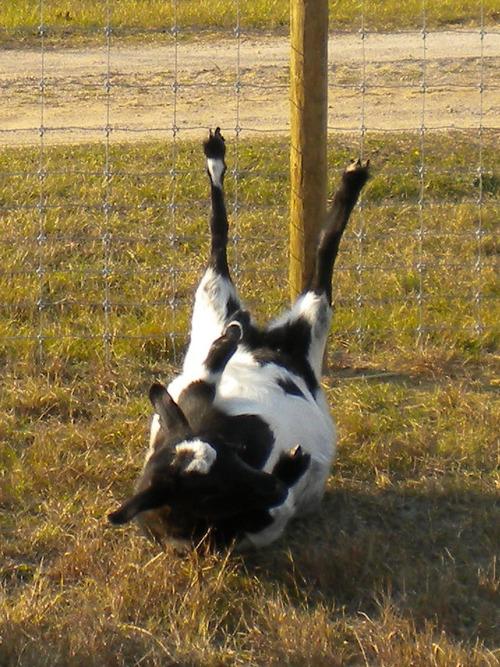Feature:
Fainting Goats
"A Fainting Goat, also known as Tennessee Fainting Goat or Myotonic goat, is a unique breed of domestic goat. Domestic goats are a subspecies of the wild goat (Capra aegagrus), & all of the various breeds share the same species. This breed, is best known for its propensity to 'faint.'...
Description of the Fainting Goat
Like all goats, these creatures have hooves on their feet, with 2 primary 'toes' rather than a single hoof like that of a horse. Many also have a pair of horns. This breed comes in a variety of different colors & patterns. They grow between 17 & 25 in. tall at the shoulder, & weigh between 60 & 175 lbs. or so.
Interesting Facts About the Fainting Goat
This interesting breed of goat has a number of unique traits & behaviors...
Fainting Behavior – The first thing you’ll notice about this breed is that they 'faint.' When surprised, individuals stiffen up & fall over. This is not a true 'faint,' as the goats do not lose consciousness.
The Mechanics – These goats 'faint' because of a genetic disorder known as Myotonia congenita. To put it simply, this disorder causes the muscles to contract & stiffen when something frightens the animal.
Why Fainting Goats? – Hypothetically, you wouldn’t want to breed a goat with a genetic disorder, so why have breeders continued this line of goats? Farmers originally kept this breed as a 'sacrificial lamb.' If a predator attacks a herd of expensive farm animals, it will eat the Myotonic goat because the goat is easy prey, saving the farmer money.
Modern Purpose – Nowadays, people tend to keep this breed as a novelty. They raise them as pets, & breed them to maintain the fainting behavior. Some individuals 'faint' more than others.
Habitat of the Fainting Goat
This breed came from other fully domestic goats. People domesticated those goats many years ago. They have always lived in manmade habitats.
Generally, people keep these goats on farmland or pasture with plenty of grass & shrubbery to eat. However, some also keep them in forests, mountainous regions, marshes, woodlands, & more.
Distribution of the Fainting Goat
The original ancestors of this breed came from Tennessee. You can trace their ancestry back to a single herd of goats. The breed quickly garnered popularity & interest, spreading across the state & throughout the nation. Now, you can find this breed in various regions of the world.
Diet of the Fainting Goat
Like all goats, this breed has herbivorous feeding habits. They will eat a wide variety of different plants. Unlike horses & sheep, goats do not only graze on grass, but browse on just about any plant. This means that their diet contains grass, shrubs, leaves, bushes, & virtually any edible plant matter.
Like any domestic breed, this goat would not exist without human interaction. Farmers have used this breed historically to protect more expensive livestock. When the Fainting Goat falls over, the predator attacks them & leaves the more valuable livestock. Now people also keep them as pets, breed them, & use their meat.
Domestication
The original ancestors of this breed came from other domestic goats. A farmer in Tennessee had a herd of goats with this genetic deformity. From this herd, people continued to breed the goats to expand the genetics. Breeders select goats with the strongest 'fainting' behavior to reproduce.
Does the Fainting Goat Make a Good Pet
Yes, this breed of goat can make a wonderful pet, but they are not house pets. Properly socialized individuals have a friendly demeanor. If you keep this breed, you must provide ample space & pasture for them to graze & exercise, medical care, & shelter from the elements. You should do your research before purchasing any pet.
Fainting Goat Care
All goat breeds have social behavior, & you must house them in groups. They need plenty of space to exercise & forage for food, & you should provide them with additional hay or grain to supplement their diet. Additionally, this breed in particular can fall prey to predators quite easily, & you must have secure fencing to keep them safe.
Behavior of the Fainting Goat
The most notable feature of this breed’s behavior is its propensity to 'faint.' When frightened, be it by a person, dog, loud noise, or unknown object, the goat’s muscles stiffen & some even fall over. Some individuals have a stronger reaction to a frightening stimulus, while others have a less severe reaction.
Reproduction of the Fainting Goat
Though females reach sexual maturity at just a few months old, you should not breed them until they reach about 6 to 9 months of age. Males reproduce with multiple females. After mating, the gestation period lasts about 5 months. The females give birth to 2 or 3 offspring, known as 'kids.' A single female can breed every 6 months."
Animals Network Team










No comments:
Post a Comment